Menus
- Evolution of the 899
- Euro 4 as standard
- Discovery
- Technical
- In the saddle
- On track
- Part-cycle
- Braking
- Conclusion
- Colors
Evolution of the 899
Evolution of the 899, the Ducati 959 Panigale is the manufacturer’s first Euro4 sports car. Intrusive, the standard imposes its straitjacket, but the electronics know how to revive the aesthetic super-midsize of the Italian manufacturer.
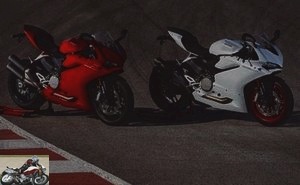
Euro 4 as standard
For almost 30 years, Ducati sports pairs have been showing their transalpine character in the form of stylish siblings.. Accompanied by an inevitable inflation of displacement, performance and prices. Thus, the end of the 90s saw the legendary 916 being accompanied by a version 748 and the following decade multiplied the Italian peers. The daring 999 and 749 were replaced by the attractive 1098 and 848, evolving rapidly in 1198 and 898. The current decade gives way to the devastating Panigale 1199 and 899. Finally, the 1299 Panigale of this year became essential a false twin: the 959. Its engine capacity of…. 955 cc makes it the industry-leading mid-size.
It is on the Ricardo Tormo circuit of Valencia, theater of the last round of MotoGP, that Ducati invites us to try the latest version of its "entry-level" sports car..
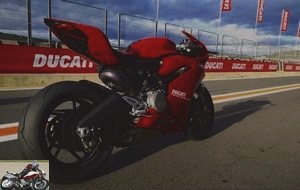
Discovery
The Panigale aesthetic is a delight of Italian design. Sharp, sporty almost aggressive but still elegant. Compact, narrow, the 959 sculpts its forms of racing art with mastery. Racy, the Ducati line is a demonstration of style. All the more reason to blame the narrow-minded decision-makers of Euro 4, degrading the sublime plastic of the 959 by a massive and coarse pair of superimposed silencers, in the right side position.
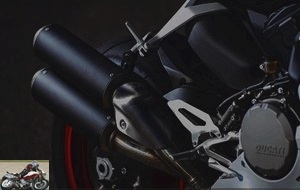
Goodbye then, in Europe, the pots under the machine, where it is now difficult to place imposing catalyst and silencer. An aesthetic evil for an ecological good (?) ….
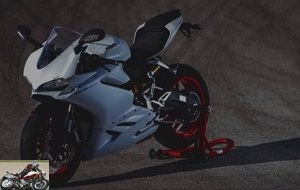
The front side evolves slightly, widening discreetly. Additional air intakes move on the ends of the sides framing an angular fire. Likewise, the bubble is slightly higher, surrounded by redesigned mirrors and new gills open the fairing. Complex and flattened, the volumes of the 17-liter tank are based on a refined rear loop. Sheathed, its hollowed-out upper volumes mimic tunnels with Venturi effects and conclude with a LED tail light with unparalleled aesthetics..
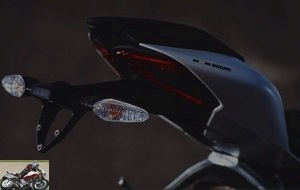
The whole thing supports remarkable passenger footrest plates, with machined ends offering better adhesion to the soles of the boots. The innards of the Italian are revealed to you in a technical part.
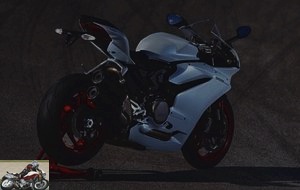
Perfectly finished and adjusted, the components of the 959 Panigale suffer from no complaints. Only the accessibility to the crutch is really delicate. Finely integrated into the casing, it forces the foot to contort until the short aluminum lateral support is deployed. But it’s beautiful.
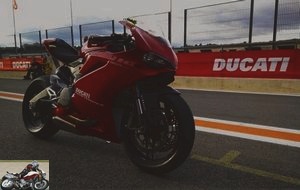
Technical
Under this tapered dress, the aerial structure of the 959 Panigale is barely revealed, from which it takes most of its predecessor. Uncluttered, the frame combines two aluminum monohull elements. The desmodromic twin tilted 21 ° back, with four valves per cylinder and cooled by liquid, which fitted the 899 has significantly improved. The L-shaped Superquadro twin-cylinder of the 959 Panigale cube now…. 955 cm3. The little moth now delivers the trifle of 157 hp at 10,500 rpm and a torque of 10.74 da.Nm at 9,000 revolutions. That is, respectively plus 9 and plus 0.8 units per value and 250 turns lower. And now…. it’s full even with us. However, the final reduction is slightly longer, going from 14×44 to 15×43…. standard obliges.
This cavalry is, of course, under the yoke of many learned chips in order to make the most of it on the road or circuit. The Ducati 959 Panigale benefits from three driving modes (Race, Sport, Wet 100 hp), influencing the arrival of power via the Ride by Wire accelerator and electronic assistance. These are composed of an engine brake adjustment EBC (Engine Brake Control) adjustable on 3 levels, a traction control DTC adjustable on 8 values and the ABS stroke with three variables. Braking is thus supervised by a Bosch 9MP ABS control unit. All these parameters, indicated on the black and white LCD dashboard, at three lighting intensities, are therefore modulated by the choice of engine mapping..
Innovation on a "medium displacement" Superquadro block, a servomotor system constitutes the anti-dribble. Another novelty, the sports car incorporates the DQS (Ducati Quick Shifter) which can be deactivated. As an option, the 959 Panigale can be equipped with DDA + (Ducati Data Analyzer Plus) coupled with a GPS.
The weight is on the rise. The 959 Panigale is 7 kilos heavier than the 899 (176 kilos dry compared to 169).
And if you really want to read more about all the mechanical details, follow the 959 Panigale technical guide..
In the saddle
With 830 mm of saddle height and an unusual narrowness, the 950 Panigale seems a sulphurous toy. Dressed in a brushed mat coating, rather comfortable, the seats are probably the most welcoming elements on board. For older children, the ergonomics seem a bit tight. An instrument devoted to sport, the Ducati does not bother with unnecessary wasted spaces. High and back, its footrests tilt the body forward and the eyes on its perforated aluminum upper yoke, cut in the mass. Y is flush with the fork tube plugs, fitted with hydraulic adjustment knobs.
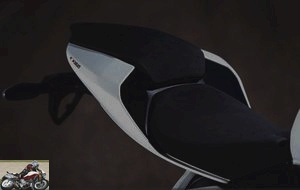
Above, a large mono-chrome TFT screen easily delivers the wealth of information available. At the top, the bar-graph tachometer covers the tachometer. Next to it, the selected engine mode is displayed as well as the EBC (engine brake control), ABS and DTC (traction control) values. The choice of engine maps influences each of these assistance and it is also possible to parameter them individually according to personal tastes. Gear indicator engaged, clock, engine and exterior temperature, speed and average consumption, odometer and partial complete these data. Clear, easy to use, the screen is above all very readable, on all occasions.
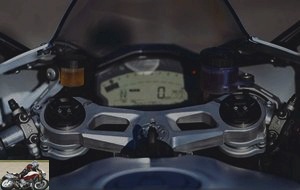
On track
A rapid, dry cough precedes the ample growls of the twin. Ample but more cavernous. In Sport mode (EBC at its strongest, i.e. 1, ABS 2 and DTC 5), it’s time to set sail on the technical track of Valence.
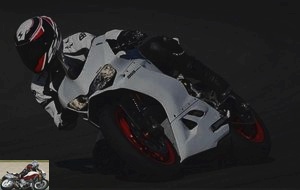
At first glance, the 959 is not easy to take and requires a certain commitment from its pilot. And this road-typed mapping already reveals the standardized crossings of a fourth-name legislation. Less than 7,000 laps in third, the super-midsize Panigale struggles to show the teeth that we knew from its predecessor. A gear below and it’s the injection that shakes the pilot and machine with a sharp movement on the go-around. Abrupt at high speed, it makes constant speed on the angle difficult. Especially since the engine brake, too present, does not help matters when entering a curve. And to get out of it, the DTC sometimes regulates the reminders too much. Finally, the development while more or less steep curves of the circuit does not facilitate the task of the first-time buyer that I am in these places. In short, the first session leaves you perplexed and impatient to get back on the handlebars to better discover the Transalpine.
First of all, switch to Race mode, which is logically more suitable. If it is already reducing the engine brake, it seems advisable to force the line by customizing its value. The ABS goes to minimum and the DTC to 3. It doesn’t take more than a few turns to find a more Latin character and a more natural and incisive behavior. The voluntary block finally becomes more demonstrative from the mid-regime, relaunching the Panigale without drought and with much more conviction. And the jerks disappear.
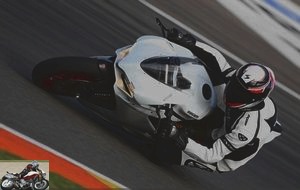
Enough to appreciate the QTS shifter to shift gears on the fly without cutting. With its lengthened stroke boosting torque, the L-twin is noticeably fuller. However, in terms of power and despite 9 additional horsepower, the straight line still leaves a feeling of lack. Logically, the crown lost a tooth to gain a standard…. We still do the 260 km / h before grabbing the brake lever.
But let’s come back to the sequences of the Iberian tourniquet. As the machine no longer over-pilot, it is easier to control it when setting the angle and to conserve gas. Likewise, exits from curves are more efficient, still under the control of an anti-skid system which is now less intrusive. If the 959 is not an obvious mount, it now delivers more under the guidance of its pilot. Rigid, the machine turns in a block but it is necessary to engage the body to take it with precision on the chosen trajectory. Once placed, the Italian is perfectly stable. Responsive to the pressure on the footrests, the Panigale goes from one side to the other all the more easily as its rims fit, for us, Pirelli Diablo Supercorsa SC. Their pointed profile necessarily boosts the Ducati’s agility, as well as its traction. If the 4 mm shock absorber and swingarm axle also influence, these racing envelopes further improve the feeling..
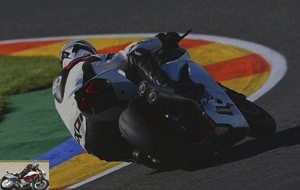
Thrown full six in front of the pits or three between two curves, the 959 Panigale slows down to a finger. Radial master cylinder and monobloc calipers easily withstand the strongest decelerations. These can cause a lack of deductibility. But the brakes are kept on the angle for a long time, without parasitic movement. Stacking gears is done with the same ease, both because of the anti-dribble and a clutch handle with remarkable flexibility. Likewise, the gearbox works with great precision, whatever the engine load. Finally, although a bit supple on the track, the suspensions do an excellent job, both in acceleration and in the brakes. The fork works efficiently at the end of the stroke and the shock absorber absorbs the ardor of the Bologna twin. By slightly increasing the compression and closing the trigger in the same way, the 959 gains noticeably in precision and agility. However, you have to pay with your person to correct too random trajectories and take care of your piloting..
Deep, the vocals of the 959 are ultimately more attractive in series exhaust than with Akrapovic silencers. To recover the original sound, it will be necessary to go through the complete titanium line, leading to the cartridges placed in the low position. At around € 5,000, this accessory gives back all its meaning and its mechanical potential to the beautiful Italian. A pleasure to listen to and which does justice to the block, giving 5% more power at 8000 rpm and removing 6 kilos !
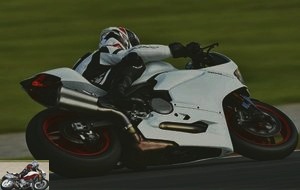
Part-cycle
Rigid and efficient, the 959 Panigale can count on its top-of-the-range equipment to optimize precision and agility. Not very intuitive, it requires attention and quality management to express itself at best.
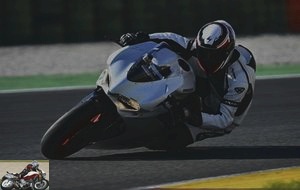
Braking
The retarder equipment does not change with high-end Brembo equipment. Brembo M4.32 monobloc calipers with radial mounting and 4 pistons attack the semi-floating 320mm discs of the front axle. The rear is fitted with a 245mm disc and two-piston caliper. Radial master cylinders and braided hoses complete this endowment, assisted by a Bosch racing ABS installed as standard. If values 2 and 3 prevent the rear wheel from taking off, level 1 gives it complete freedom.
Powerful and enduring, the Brembo equipment provides top-notch decelerations but lacks openness on the heaviest braking. Rather transparent on the minimum setting, ABS plays its role perfectly, making it possible to delay the grip of the lever as well as possible and to keep the brakes on the angle for a long time.
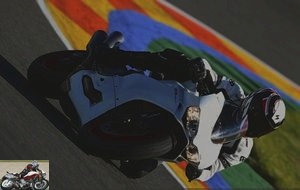
Conclusion
Sporty sculpture, remarkably equipped, the Ducati 959 Panigale undergoes the castrating pangs of the Euro4 standard, both in terms of aesthetics and mechanical behavior. Less character, the block also bears the cost of a (slightly) extended gearbox. Despite performance figures on the rise, the engine response sometimes seems too smoothed by the effects of legislation that is not very credible. Less demonstrative, the super-midsize athlete knows how to remain efficient on the circuit, as long as one adjusts his numerous electronic assistance. Likewise, its high-end cycle part and an important asset.
Priced at 16,590 € in red and 16,790 € in white, the 959 Panigale offers a performance / price ratio in line with its equipment. However, the Aprilia RSV4 RR only asks for € 17,200 to give access to more performance. Claiming € 21,290, the 1299 Panigale offers much more passion and temperament. But what will happen to these last two when the Euro4 will be passed over them??
A simple change of crown (+3 teeth) would probably change the personality of the 959. Not quite a 1.000 cm3 but really more of a small sportswoman, the little Panigale evolves, alone, between two worlds. A separate object, this is perhaps its major argument for attracting bikers looking for a new intermediate category. Attractive, the 959 is worth the detour and is only available to demanding pilots.
Strong points
- Racy aesthetics
- Efficient electronics
- Precision of the chassis
Weak points
- Diluted character
- Vivacity to be tested on imperfect coating
- Not very intuitive
- Exhaust not very elegant
.
The technical sheet of the Panigale
Colors
- Ducati Red, Gloss Black rims.
- Arctic White silk, red rims.
Related articles
-
A queen who treats you By their personality, their characteristics and their performances, the Ducati have always been motorcycles apart. La Panigale is…
-
Authentic sensations Ducati knows how to offer models that transcend its history, such as its Monster, in its range. The success of the latter is based…
-
Ducati Monster 620 motorcycle test
Biker testing: Garfield Ducati and me, it’s a long platonic love story. Between in high school in the late 80s, the teenager I was did not fail to swoon…
-
A Monster charm Since its origins, the Monster Desmodue saga has been written in tandem, combining high displacement models (from M900s to M1200s) with a…
-
Ducati Panigale V4 S motorcycle test
The price of the exception V4, 1103 cm3, 214 hp and 124 Nm, 195 kg all full facts, 28,890 euros The bike that was being born was obviously exceptional:…
-
Ducati Panigale V2 motorcycle test
Mini-V4, maxi-pleasure? Controlled origin flavor V-twin Superquadro 955 cm3, Euro5, 155 hp and 104 Nm, 176 kg dry, 18,290 euros Family culture obliges,…
-
THE Successful Monster Ducati has been offering its successful roadster since 1992. The R versions symbolize the maximum sportiness of these machines. We…
-
Light up your dark side The Monster saga has been written since 1993 with its large displacement models M900, M1000 ie, S4R, M1100. But the younger girls…
-
Always so surprising L-Twin Testastretta DVT, 1262 cm3, 159 hp, 129 Nm (13.1 mkg), 244 kg full made, 17 liter tank, € 20,490 and € 23,490 in S version…
-
Naked original 3.0 Legendary bestseller of the Italian brand, the Monster is the archetype of the undressed roadster. Dressed in essentials, the new…